Posted On: Jun 15, 2016
You can now quickly create cross-region read replicas for your unencrypted Amazon RDS for PostgreSQL database instances with just a few clicks on the AWS Management Console. You can use this feature to reduce read latency for your customers in different geographic locations, to create a backup of your primary database for disaster recovery purposes, or quickly migrate your database to a different AWS Region.
Disaster Recovery: You can create cross-region read replicas of your primary database instance to have a disaster recovery solution. If your primary region faces a disruption, you can promote the replica to a master and keep your business operational.
Scaling: You can use cross-region read replicas to support read queries from your workloads across various geographic locations. This will reduce latency by serving your customers from a database that is close to them.
Cross-region Migration: If you would like to migrate your database instance quickly to another AWS region, you may do so by using cross-region replication. Simply create a replica in your target region, and once it is ready, promote it to master and point your application to it.
This feature is available for all RDS PostgreSQL databases that are version 9.5.2 or 9.4.7 and higher. To create a cross-region replica of a database instance operating on an older version, you can upgrade to a supported version by performing a database version upgrade. To learn more about cross-region replication for RDS PostgreSQL, please refer to the RDS documentation.
New – Cross-Region Read Replicas for Amazon Aurora
https://aws.amazon.com/cn/blogs/aws/new-cross-region-read-replicas-for-amazon-aurora/
by Jeff Barr | on 01 JUN 2016 | in Amazon Aurora, Amazon RDS, Launch, News | Permalink | Share
You already have the power to scale the read capacity of your Amazon Aurora instances by adding additional read replicas to an existing cluster. Today we are giving you the power to create a read replica in another region. This new feature will allow you to support cross-region disaster recovery and to scale out reads. You can also use it to migrate from one region to another or to create a new database environment in a different region.
Creating a read replica in another region also creates an Aurora cluster in the region. This cluster can contain up to 15 more read replicas, with very low replication lag (typically less than 20 ms) within the region (between regions, latency will vary based on the distance between the source and target). You can use this model to duplicate your cluster and read replica setup across regions for disaster recovery. In the event of a regional disruption, you can promote the cross-region replica to be the master. This will allow you to minimize downtime for your cross-region application. This feature applies to unencrypted Aurora clusters.
Before you get actually create the read replica, you need to take care of a pair of prerequisites. You need to make sure that a VPC and the Database Subnet Groups exist in the target region, and you need to enable binary logging on the existing cluster.
Setting up the VPC
Because Aurora always runs within a VPC, ensure that the VPC and the desired Database Subnet Groups exist in the target region. Here are mine:
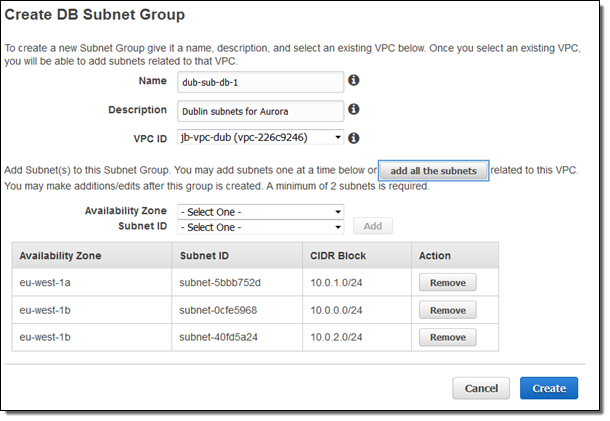
Enabling Binary Logging
Before you can create a cross region read replica, you need to enable binary logging for your existing cluster. Create a new DB Cluster Parameter Group (if you are not already using a non-default one):
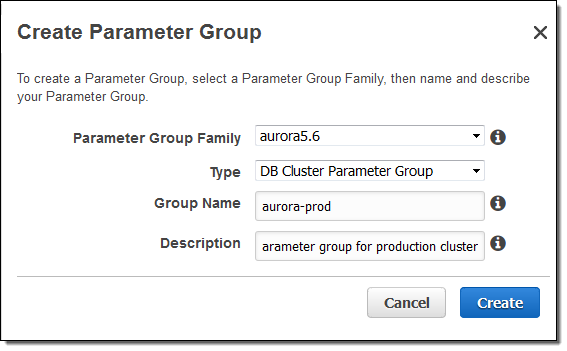
Enable binary logging (choose MIXED) and then click on Save Changes:
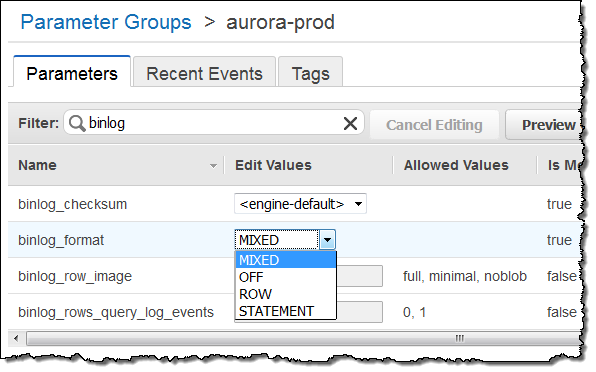
Next, Modify the DB Instance, select the new DB Cluster Parameter Group, check Apply Immediately, and click on Continue. Confirm your modifications, and then click on Modify DB Instance to proceed:

Select the instance and reboot it, then wait until it is ready.
Create Read Replica
With the prerequisites out of the way it is time to create the read replica! From within the AWS Management Console, select the source cluster and choose Create Cross Region Read Replica from the Instance Actions menu:
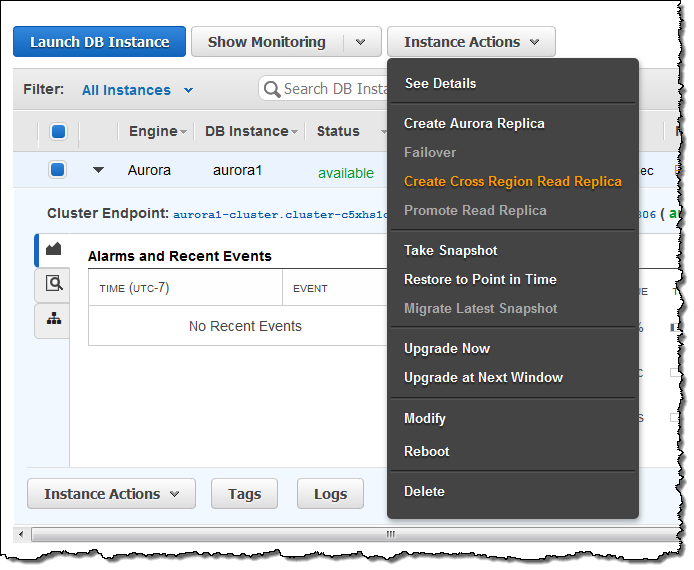
Name the new cluster and the new instance, and then pick the target region. Choose the DB Subnet Group and set the other options as desired, then click Create:
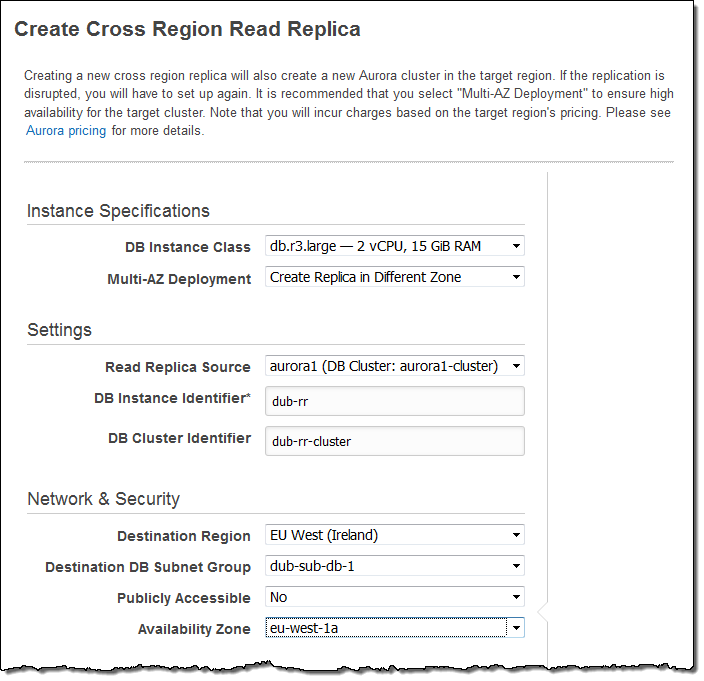
Aurora will create the cluster and the instance. The state of both items will remain at creating until the items have been created and the data has been replicated (this could take some time, depending on amount of data stored in the existing cluster.
This feature is available now and you can start using it today!
— Jeff;
Cross-Region Read Replicas for Amazon RDS for MySQL
https://aws.amazon.com/cn/blogs/aws/cross-region-read-replicas-for-amazon-rds-for-mysql/
by Jeff Barr | on 26 NOV 2013 | in Amazon RDS, Amazon Redshift | Permalink | Share
You can now create cross-region read replicas for Amazon RDS database instances!
This feature builds upon our existing support for read replicas that reside within the same region as the source database instance. You can now create up to five in-region and cross-region replicas per source with a single API call or a couple of clicks in the AWS Management Console. We are launching with support for version 5.6 of MySQL.
Use Cases
You can use this feature to implement a cross-region disaster recovery model, scale out globally, or migrate an existing database to a new region:
Improve Disaster Recovery – You can operate a read replica in a region different from your master database region. In case of a regional disruption, you can promote the replica to be the new master and keep your business in operation.
Scale Out Globally – If your application has a user base that is spread out all over the planet, you can use Cross Region Read Replicas to serve read queries from an AWS region that is close to the user.
Migration Between Regions – Cross Region Read Replicas make it easy for you to migrate your application from one AWS region to another. Simply create the replica, ensure that it is current, promote it to be a master database instance, and point your application at it.
You will want to pay attention to replication lag when you implement any of these use cases. You can use Amazon CloudWatch to monitor this important metric, and to raise an alert if it reaches a level that is unacceptably high for your application:
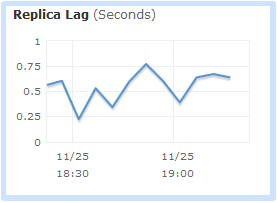
As an example of what you can do with Cross Region Replicas, here’s a global scale-out model. All database updates (green lines) are directed to the database instance in the US East (Northern Virginia) region. All database queries (black lines) are directed to in-region or cross-region read replicas, as appropriate:
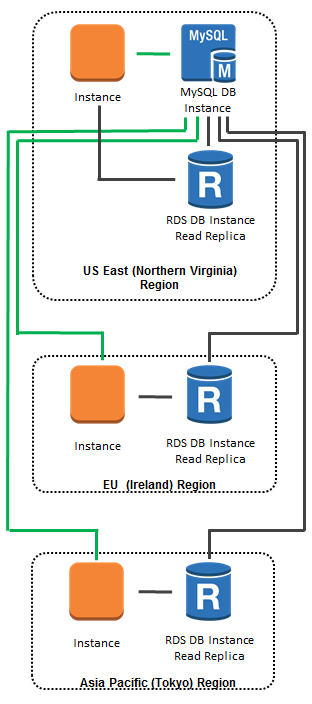
Creating Cross-Region Read Replicas
The cross-region replicas are very easy to create. You simply select the desired region (and optional availability zone) in the AWS Management Console:
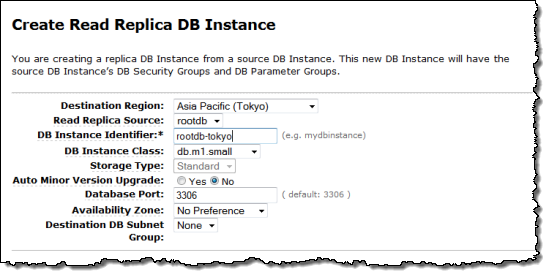
You can also track the status of each of your read replicas using RDS Database Events.
All data transfers between regions are encrypted using public key encryption. You pay the usual AWS charges for the database instance, the associated storage, and the data transfer between the regions.
Reports from the Field
I know that our users have been looking forward to this feature. Here’s some of the feedback that they have already sent our way:
Isaac Wong is VP of Platform Architecture at Medidata. He told us:
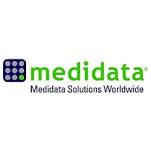 Medidata provides a cloud platform for life science companies to design and run clinical trials faster, cheaper, safer, and smarter. We use Amazon RDS to store mission critical clinical development data and tested many data migration scenarios between Asia and USA with the cross region snapshot feature and found it very simple and cost effective to use and an important step in our business continuity efforts. Our clinical platform is global in scope. The ability provided by the new Cross Region Read Replica feature to move data closer to the doctors and nurses participating in a trial anywhere in the world to shorten read latencies is awesome. It allows health professionals to focus on patients and not technology. Most importantly, using these cross region replication features, for life critical services in our platform we can insure that we are not affected by regional failure. Using AWS’s simple API’s we can very easily bake configuration and management into our deployment and monitoring systems at Medidata.
Medidata provides a cloud platform for life science companies to design and run clinical trials faster, cheaper, safer, and smarter. We use Amazon RDS to store mission critical clinical development data and tested many data migration scenarios between Asia and USA with the cross region snapshot feature and found it very simple and cost effective to use and an important step in our business continuity efforts. Our clinical platform is global in scope. The ability provided by the new Cross Region Read Replica feature to move data closer to the doctors and nurses participating in a trial anywhere in the world to shorten read latencies is awesome. It allows health professionals to focus on patients and not technology. Most importantly, using these cross region replication features, for life critical services in our platform we can insure that we are not affected by regional failure. Using AWS’s simple API’s we can very easily bake configuration and management into our deployment and monitoring systems at Medidata.
Joel Callaway is IT Operations Manager at Zoopla Property Group Ltd. This is what he had to say:
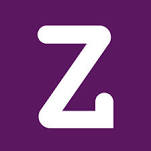 Amazon RDS cross region functionality gives us the ability to copy our data between regions and keep it up to date for disaster recovery purposes with a few automated steps on the AWS Management Console. Our property and housing prices website attracts over 20 million visitors per month and we use Amazon RDS to store business critical data of these visitors. Using the cross region snapshot feature, we already transfer hundreds of GB of data from our primary US-East region to the EU-West every week. Before this feature, it used to take us several days and manual steps to do this on our own. We now look forward to the Cross Region Read Replica feature, which would make it even easier to replicate our data along with our application stack across multiple regions in AWS.
Amazon RDS cross region functionality gives us the ability to copy our data between regions and keep it up to date for disaster recovery purposes with a few automated steps on the AWS Management Console. Our property and housing prices website attracts over 20 million visitors per month and we use Amazon RDS to store business critical data of these visitors. Using the cross region snapshot feature, we already transfer hundreds of GB of data from our primary US-East region to the EU-West every week. Before this feature, it used to take us several days and manual steps to do this on our own. We now look forward to the Cross Region Read Replica feature, which would make it even easier to replicate our data along with our application stack across multiple regions in AWS.
Time to Replicate
This feature is available now and you can start using it today!
You may also want to investigate some of our other cross-region features including EC2 AMI Copy, RDS Snapshot Copy, DynamoDB Data Copy, and Redshift Snapshot Copy.